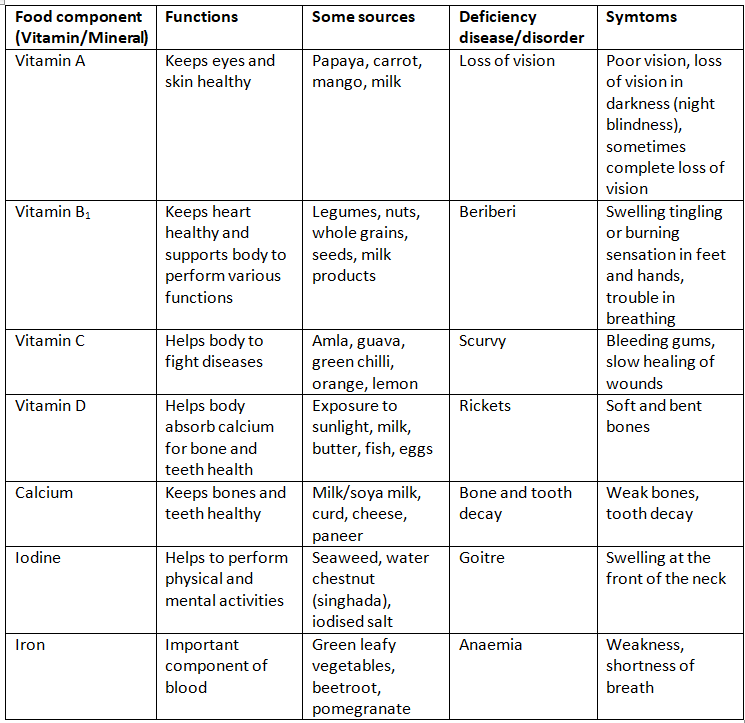NCERT Solutions for Ch 3 Mindful Eating A Path to a Healthy Body Class 6 Science
Book Solutions1
(i) Jowar, Bajra, Ragi, Chana
(ii) Kidney beans, Green gram, Soya bean, Rice
Answer
(i) “Chana” is the odd one out because it is a pulse (legume), while Jowar, Bajra, and Ragi are millets (cereals).(ii) “Rice” is the odd one out because it is a cereal, while Kidney beans, Green gram, and Soya bean are all pulses (legumes).
2
Answer
Traditional culinary practices in India involve:
• Use of local and fresh ingredients.
• Slow cooking methods on chulhas (clay stoves).
• Handmade utensils like mortar, stone grinder and pestle.
Modern culinary practices involve:
• Use of processed and packaged food.
• Fast cooking methods like pressure cooking and modern gas stoves.
• Electric appliances like blenders and microwaves.
While modern practices are more convenient, traditional practices often retain more nutrients and flavours. These changes are due to different factors such as technological development, improved transportation, availability of a variety of ingredients, time constraints and lifestyle changes.
3
Answer
Two possible questions Ravi could ask his teacher are:i. What are some examples of foods that can act as medicine?
ii. How do these foods help in preventing or curing diseases?
4
Answer
Delicious foods like pizza, burgers, and ice creams are often high in fats, sugars, and calories but low in nutrients. They are not always healthy.On the other hand, nutritious foods like bitter gourd, spinach, and sprouts may not be as tasty for some people. They may not be always tasty but are very good for health.
It’s important to find a balance and make healthy foods more appealing by experimenting with different recipes and cooking methods.
5
Answer
Medu should include more fruits, vegetables, and whole grains in his diet. These foods are rich in fibre which helps in digestion and prevents constipation.He should also reduce his intake of processed foods like biscuits, noodles, and white bread as they are low in fibre and nutrients.
Drinking enough water throughout the day will also help relieve constipation.
6
(i) Which deficiency disease is she suffering from?
(ii) Which food component may be lacking in her diet?
(iii) Suggest some food items that she should include in her diet to overcome this problem (any four).
Answer
(i) Reshma is suffering from night blindness, which resulted in trouble seeing things in dim light.(ii) Vitamin A may be lacking in Reshma's diet as deficiency of Vitamin A causes night blindness.
(iii) Reshma should include foods rich in Vitamin A like carrots, green leafy vegetables (spinach, kale), sweet potato, papaya, mango, milk, and eggs in her diet.
7
You are provided the following:
(i) Canned fruit juice
(ii) Fresh fruit juice
(iii) Fresh fruit
Which one would you prefer and why?
Answer
I would prefer fresh fruit. Fresh fruits are the most nutritious as they retain all their vitamins, minerals, and fibre.Fresh fruit juices are a good second choice as they contain most of the nutrients, but the fibre is lost. Canned fruit juices often have added sugars and preservatives, and may lose some nutrients during processing.
8
(i) Why did the doctor give calcium tablets to Gourav?
(ii) On the second visit, why did the doctor give Vitamin D syrup along with calcium tablets?
(iii) What question arises in your mind about the choices made by the doctor in giving the medicines?
Answer
(i) The doctor gave calcium tablets to Gourav to help in the healing and strengthening of his fractured bone.(ii) Vitamin D helps the body absorb calcium better. So, the doctor gave Vitamin D syrup to ensure better absorption of the calcium tablets for faster healing.
(iii) The question that arises is: Why was Vitamin D not given in the first visit along with calcium tablets?

9
Answer
Iodine solution reacts specifically with starch, not with simple sugars. It is used to test the presence of starch in a substance. When iodine comes into contact with starch, it forms a blue-black complex. Sugar is a simple carbohydrate and does not contain starch, therefore it does not change colour when tested with iodine solution.10
Answer
Raman’s statement is correct. All starches are complex carbohydrates, but not all carbohydrates are complex. Simple carbohydrates like sugars are not starches.To test this, we can take different food items like sugar, bread, potato, and milk. We can test each food item with iodine solution.
The food items containing starch (like bread and potato) will turn blue-black, while those containing simple carbohydrates (like sugar and milk) will not change colour.
11
Answer
The teacher’s saree likely contains starch (like in cotton or linen), which reacts with iodine to turn blue-black.Mishti’s socks are likely made of synthetic fibres like polyester or nylon, which do not contain starch and therefore do not react with iodine.
12
Answer
Millets are considered a healthy food choice because they are rich in nutrients like proteins, minerals, vitamins, and fibre. However, eating just millets cannot suffice for all the nutritional needs of the body.Our body requires a variety of nutrients from different food groups like pulses, fruits, vegetables, and dairy products for overall health and development. Millets can be a healthy part of a balanced diet.
13
Answer
To check if a given solution is an iodine solution, we can perform a starch test. We can take a food item rich in starch (like potato or bread) and add a few drops of the given solution on it.If the solution is iodine, the food item will turn blue-black, confirming the presence of starch. If there is no colour change, the given solution is not iodine.